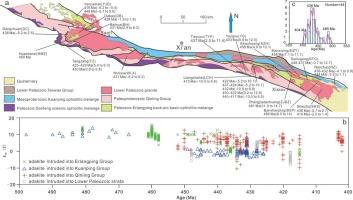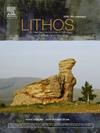中国秦岭北麓志留纪-元古代的斑岩和花岗伟晶岩长脉:多期岩浆活动及其对构造演化的影响
IF 2.5
2区 地球科学
Q2 GEOCHEMISTRY & GEOPHYSICS
引用次数: 0
摘要
北秦岭造山带早古生代英达岩和花岗伟晶岩的岩石成因和构造背景是备受争议的问题。锆石UPb测年显示,会池子岩体由早志留纪花岗闪长岩、晚志留纪花岗闪长岩和早泥盆纪花岗伟晶岩岩脉组成。伟晶岩尖晶岩的平均εHf(t)值为-2.8,低于早志留纪(4.8)和晚志留纪花岗闪长岩(5.1)。值得注意的是,早志留纪和晚志留纪花岗闪长岩具有英安岩特征,是由增厚的幼年黑云母下地壳部分熔融形成的。此外,早泥盆世伟晶岩尖晶岩显示出大量的碎屑结晶。它们来自混合来源的部分熔融,包括地壳和地幔物质。北秦岭造山带的早古生代英安岩按其地球化学特征可分为四类。第一组(496-458 Ma)阿达基特岩富含Na,εHf(t)值极高。它们是由二郎坪后弧洋壳部分熔融形成的。第二组(454-420 Ma)的阿达基特岩富含Na或K,εHf(t)值不一。它们是由上丹洋俯冲过程中形成的黑云母岩浆下压增厚的下地壳部分熔融并含有各种地幔成分而形成的。第三组(420-410 Ma)和第四组(410-400 Ma)阿达克岩分别由碰撞和碰撞后环境下增厚的下地壳部分熔融形成。本文章由计算机程序翻译,如有差异,请以英文原文为准。

Silurian-devonian adakites and granitic pegmatitic dikes in North Qinling, China: Multi-stage magmatism and implications for the tectonic evolution
The petrogenesis and tectonic setting of early Paleozoic adakites and granitic pegmatites in the North Qinling orogenic belt are highly debated issues. Zircon U![]() Pb dating revealed that the Huichizi pluton is composed of the Early Silurian granodiorites, Late Silurian granodiorites, and Early Devonian granitic pegmatite dikes. The average εHf(t) value of pegmatite dikes was −2.8, which is lower than those of the Early Silurian (4.8) and Late Silurian granodiorites (5.1). It is worth noting that the Early Silurian and Late Silurian granodiorites exhibited adakitic characteristics and were formed through the partial melting of a thickened juvenile mafic lower crust. In addition, the Early Devonian pegmatite dikes displayed a substantial fractional crystallization. They were derived from the partial melting of mixed sources, including the crustal and mantle materials. The early Paleozoic adakitic rocks in the North Qinling orogenic belt can be categorized into four groups according to their c geochemical characteristics. The adakitic rocks of the first group (496–458 Ma) were rich in Na and exhibited extremely high εHf(t) values. They were formed by the partial melting of the Erlangping back-arc oceanic crust. The adakitic rocks of the second group (454–420 Ma) exhibited enriched Na or K contents and varying εHf(t) values. They were derived from the partial melting of a thickened lower crust with various mantle components, underplated by mafic magma formed during the subduction of the Shangdan Ocean. The adakites of the third (420–410 Ma) and fourth (410–400 Ma) groups were formed by the partial melting of a thickened lower crust under collisional and post-collisional settings, respectively.
Pb dating revealed that the Huichizi pluton is composed of the Early Silurian granodiorites, Late Silurian granodiorites, and Early Devonian granitic pegmatite dikes. The average εHf(t) value of pegmatite dikes was −2.8, which is lower than those of the Early Silurian (4.8) and Late Silurian granodiorites (5.1). It is worth noting that the Early Silurian and Late Silurian granodiorites exhibited adakitic characteristics and were formed through the partial melting of a thickened juvenile mafic lower crust. In addition, the Early Devonian pegmatite dikes displayed a substantial fractional crystallization. They were derived from the partial melting of mixed sources, including the crustal and mantle materials. The early Paleozoic adakitic rocks in the North Qinling orogenic belt can be categorized into four groups according to their c geochemical characteristics. The adakitic rocks of the first group (496–458 Ma) were rich in Na and exhibited extremely high εHf(t) values. They were formed by the partial melting of the Erlangping back-arc oceanic crust. The adakitic rocks of the second group (454–420 Ma) exhibited enriched Na or K contents and varying εHf(t) values. They were derived from the partial melting of a thickened lower crust with various mantle components, underplated by mafic magma formed during the subduction of the Shangdan Ocean. The adakites of the third (420–410 Ma) and fourth (410–400 Ma) groups were formed by the partial melting of a thickened lower crust under collisional and post-collisional settings, respectively.
求助全文
通过发布文献求助,成功后即可免费获取论文全文。
去求助
来源期刊

Lithos
地学-地球化学与地球物理
CiteScore
6.80
自引率
11.40%
发文量
286
审稿时长
3.5 months
期刊介绍:
Lithos publishes original research papers on the petrology, geochemistry and petrogenesis of igneous and metamorphic rocks. Papers on mineralogy/mineral physics related to petrology and petrogenetic problems are also welcomed.
 求助内容:
求助内容: 应助结果提醒方式:
应助结果提醒方式:


